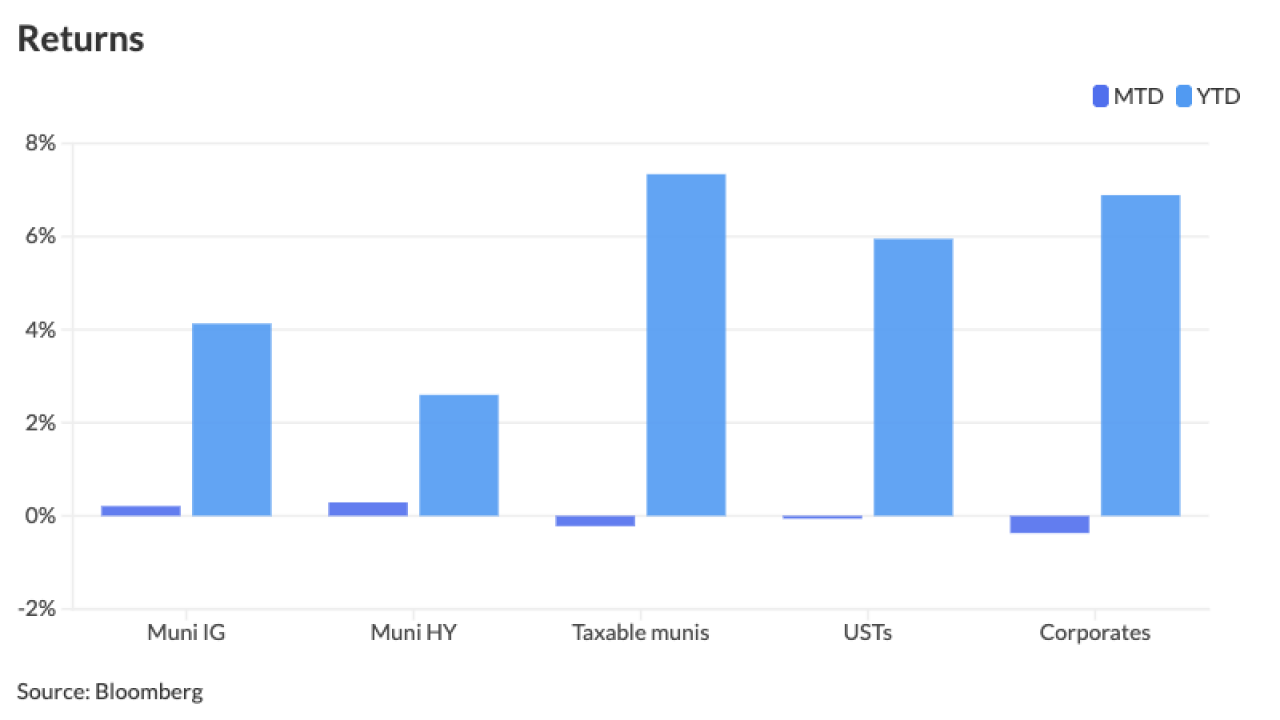The University of Illinois heads into the market Thursday with mixed agency rating views on its outlook as the state's flagship university manages through the COVID-19 fiscal storm.
The $90.6 million competitive issue offers $59.2 million of tax-exempt auxiliary facilities bonds and $31.4 million of taxable refunding bonds under the same credit. New money in the sale will provide funding to complete construction of a soccer park and acquisition of a conference center and the refunding bonds will refinance debt sold in 2010 and 2014.

The agencies rating the university took opposite outlook actions ahead of the deal.
S&P Global Ratings affirmed the university’s A-minus rating and moved its outlook to stable from negative. The rating agency had revised the state’s public universities' outlooks to negative from stable in April.
Moody’s Investors Service, which rates the university two notches higher at A1, affirmed the rating and moved the outlook to negative from stable.
The university has $1.4 billion of debt including $1.1 billion under the auxiliary credit, with the under its certificates of participation program, health system, facilities lease, and south campus credit.
The negative outlook is due to “U of I's potential exposure to further deterioration in the state of Illinois' credit quality due to the significant economic consequences of the coronavirus pandemic, worsening the state's financial challenges,” wrote Moody’s, which rates Illinois Baa3 with a negative outlook.
The university receives nearly 30% of its overall revenue from state appropriations between state aid and retirement contributions. The level was held steady in the state’s fiscal 2021 budget but Gov. J.B. Pritzker has warned of deep budget cuts if the federal government doesn’t approve new aid to make up for tax revenue losses caused by the coronavirus pandemic.
The rating benefits from the university's significant market strength, supported by its membership in the Big 10 Academic Alliance, flagship and land grant status, and large operating scope and liquid reserves that provide flexibility to manage through the non-state related financial impacts of the pandemic, Moody’s said.
S&P is now less worried then it was in April about the state flagship’s ability to manage the pandemic’s costs.
"The outlook revision reflects our opinion that UI has sufficient balance-sheet strength, expected operating stability given mitigation plans, and less reliance on state appropriations than many other public universities in the state," said S&P analyst Jessica Goldman.
The university’s strengths would warrant a stand-alone AA-minus rating, but it’s dragged down by a three-notch cap linked to its supporting government, S&P said. Illinois is rated BBB-minus.
The university suspended in-person classes in March, on campus research was curtailed to essential purposes only, a majority of personnel began working from home, and pro-rated refunds were provided to students for room and board and some student fees.
The university warns in the offering statement of the detrimental fiscal impact on its balance sheet from investments to student revenue but also cautions that it can’t fully gauge the impact yet. To soften the fiscal blow, the university cut back on hiring, reduced travel and supplies purchases, slowed or postponed some capital projects, cut executive pay, and limited pay increases.
The university has $835 million in daily liquidity available from balances in its operating fund pools that holds a total of $3 billion.
The more than 150-year-old school operates three campuses: its primary location in Urbana-Champaign, and in Chicago and Springfield.
While its ratings took hits like the state’s regional public universities during a two-year budget impasse that ended in July 2017, enrollment rose steadily to nearly 89,000 in 2019 from just over 80,000 in 2015.
The university operates on a $7 billion budget with tuition revenue continuing to rise, reaching $1.365 billion in 2019. Direct state aid accounts for another $604 million. Research grants of $941.5 million and auxiliary, institutional funds, health system, and gifts make up the remainder of the budget. Pledged revenues were $1.31 billion and cover pro forma maximum annual debt service nearly 8.0 times.
The university’s finance team at a board meeting last month warned of a $167 million hit in fiscal 2020 due to the pandemic. It received $63 million from the federal CARES Act with half going to student aid.
The school announced June 18 its fall semester plans for a mix of in-person instruction and online classes requiring students to wear face masks, practice social distancing and agree to COVID-19 testing if they return to campus for the scheduled Aug 24 start of the semester. The school will house testing stations where individuals can submit saliva samples. The university’s researchers developed a new saliva test for the disease and are seeking emergency FDA approval on it.
Municipal Market Analytics warns in its weekly outlook published Monday that the pandemic will undermine the higher education sector’s credit “but fears over the pace and severity are likely tempered (at least for now) as most colleges are planning for in-person classes next semester.”
For some, lower revenue related to enrollment, fewer international students, more tuition discounting, and less state aid and higher costs for cleaning, testing and tracing, and technology will likely accelerate decisions to shutter, MMA warns. But if schools can keep students on campus long enough until their tuition refund date expires, they will avoid revenue attrition that becomes likely with an online-only offering.
PFM Financial Advisors LLC is advising the school and Chapman and Cutler LLP is bond counsel.





